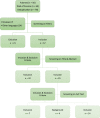The effects of advanced glycation end products (AGEs) on dermal wound healing and scar formation: a systematic review
- PMID: 29799552
- PMCID: PMC5965313
- DOI: 10.1177/2059513116676828
The effects of advanced glycation end products (AGEs) on dermal wound healing and scar formation: a systematic review
Abstract
Introduction: With ageing, the skin gradually loses its youthful appearance and functions like wound healing and scar formation. The pathophysiological theory of Advanced Glycation End products (AGEs) has gained traction during the last decade. This review aims to document the influence of AGEs on the mechanical and physiologic properties of the skin, how they affect dermal wound healing and scar formation in high-AGE populations like elderly patients and diabetics, and potential therapeutic strategies.
Methods: This systematic literature study involved a structured search in Pubmed and Web of Science with qualitative analysis of 14 articles after a three-staged selection process with the use of in- and exclusion criteria.
Results: Overall, AGEs cause shortened, thinned, and disorganized collagen fibrils, consequently reducing elasticity and skin/scar thickness with increased contraction and delayed wound closure. Documented therapeutic strategies include dietary AGE restriction, sRAGE decoy receptors, aminoguanidine, RAGE-blocking antibodies, targeted therapy, thymosin β4, anti-oxidant agents and gold nanoparticles, ethyl pyruvate, Gal-3 manipulation and metformin.
Discussion: With lack of evidence concerning scars, no definitive conclusions can yet be made about the role of AGEs on possible appearance or function of scar tissue. However, all results suggest that scars tend to be more rigid and contractile with persistent redness and reduced tendency towards hypertrophy as AGEs accumulate.
Conclusion: Abundant evidence supports the pathologic role of AGEs in ageing and dermal wound healing and the effectiveness of possible therapeutic agents. More research is required to conclude its role in scar formation and scar therapy.
Keywords: Advanced glycosylation end products (AGEs); cicatrix; connective tissue; dermal wound healing; fibrosis; photoageing; scarring; skin ageing.
Conflict of interest statement
Declaration of conflicting interests: The authors declared no potential conflicts of interest with respect to the research, authorship, and/or publication of this article.
Figures
References
-
- Viña J, Borrás C, Miquel J. Theories of ageing. IUBMB Life 2007; 59: 249–254. - PubMed
-
- Paul RG, Bailey AJ. Glycation of collagen: the basis of its central role in the late complications of ageing and diabetes. Int J Biochem Cell Biol 1996; 28: 1297–1310. - PubMed
-
- Tortora GJ, Grabowski SR. Principles of Anatomy and Physiology. New York, NY: HarperCollins College Publishers, 1993.
-
- Adam J, Singer M, Richard AF, et al. Cutaneous wound healing. N Engl J Med 1999; 341: 738–746. - PubMed
-
- Fore J. A review of skin and the effects of ageing on skin structure and function. Ostomy Wound Manage 2006; 52: 24–35. - PubMed
Publication types
LinkOut - more resources
Full Text Sources
Other Literature Sources



